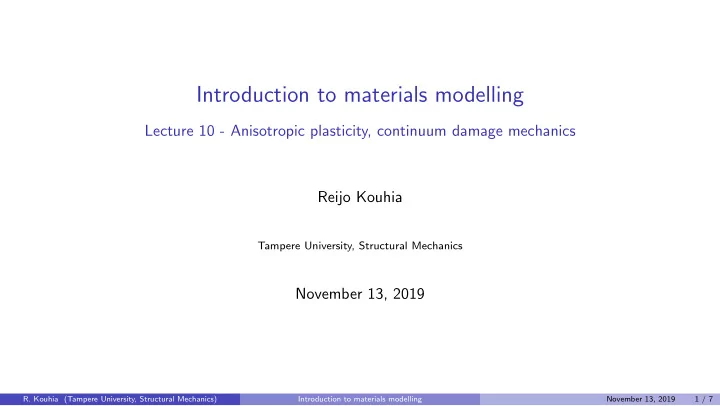

Introduction to materials modelling Lecture 10 - Anisotropic plasticity, continuum damage mechanics Reijo Kouhia Tampere University, Structural Mechanics November 13, 2019 R. Kouhia (Tampere University, Structural Mechanics) Introduction to materials modelling November 13, 2019 1 / 7
Anisotropic yield conditions Transverse isotropy: 1 f (tr σ , tr σ 2 , tr σ 3 , tr( σ M ) , tr( σ 2 M )) = 0 where M = m ⊗ m is the structural tensor for transverse isotropy. Orthotropy: 2 f (tr( σ M 1 ) , tr( σ M 2 ) , tr( σ M 3 ) , tr( σ 2 M 1 ) , tr( σ 2 M 2 ) , tr( σ 2 M 3 ) , tr σ 3 ) = 0 where M i = m i ⊗ m i are the structural tensors for orthotropy. R. Kouhia (Tampere University, Structural Mechanics) Introduction to materials modelling November 13, 2019 2 / 7
Transversely isotropic yield condition The general form f (tr σ , tr σ 2 , tr σ 3 , tr( σ M ) , tr( σ 2 M )) = 0 can also be written in terms of the deviatoric stress s f (tr σ , tr s 2 , tr s 3 , tr( sM ) , tr( s 2 M )) = 0 If the yield is independent of hydrostatic stress then f (tr s 2 , tr s 3 , tr( sM ) , tr( s 2 M )) = 0 Defining 2 tr s 2 , J 5 = tr( s 2 M ) , J L = J 5 − J 2 J 2 = 1 J T = J 2 + 1 J 4 = tr( sM ) , 4 J 4 − J 5 , 4 then the maximum shear stresses in the transverse isotropy plane τ T and in a plane containing the longitudinal axis τ L are � � τ T = J T , τ L = J L R. Kouhia (Tampere University, Structural Mechanics) Introduction to materials modelling November 13, 2019 3 / 7
Orthotropic yield condition Orthotropic von Mises-Hill type yield condition which does not depend on hydrostatic stress f (tr( sM 1 ) , tr( sM 2 ) , tr( sM 3 ) , tr( s 2 M 1 ) , tr( s 2 M 2 ) , tr( s 2 M 3 )) = 0 A classic formulation (Hill 1948, 1950) is based on the quadratic form (coordinate axes coincide to the orthotropy directions) s T P˜ ˜ s − 1 = 0 where s 11 F + G − F − G 0 0 0 s 22 − F F + H − H 0 0 0 s 33 − G − H G + H 0 0 0 ˜ s = , P = s 12 0 0 0 2 L 0 0 s 13 0 0 0 0 2 M 0 s 23 0 0 0 0 0 2 N i.e. F ( s 11 − s 22 ) 2 + G ( s 11 − s 33 ) 2 + H ( s 22 − s 33 ) 2 + 2 Ls 2 12 + 2 Ms 2 13 + 2 Ns 2 23 − 1 = 0 R. Kouhia (Tampere University, Structural Mechanics) Introduction to materials modelling November 13, 2019 4 / 7
Orthotropic yield condition (cont’d) The six parameters F, G, H, L, M and N can be solved from the uniaxial yield strengths in the orthotropy directions and from the three shear strengths F = 1 2 ( σ − 2 y1 + σ − 2 y2 − σ − 2 G = 1 2 ( σ − 2 y1 + σ − 2 y3 − σ − 2 H = 1 2 ( σ − 2 y2 + σ − 2 y3 − σ − 2 y3 ) , y2 ) , y1 ) and 2 τ − 2 2 τ − 2 2 τ − 2 L = 1 M = 1 N = 1 y12 , y13 , y23 R. Kouhia (Tampere University, Structural Mechanics) Introduction to materials modelling November 13, 2019 5 / 7
Continuum damage mechanics - introduction In 1958 Kachanov introduced a model to describe continuous degradation of a material. He introcuded a single variable - damage index or integrity - which continuosly reduces the elastic properties σ = φ C e ε e For the evolution of the integrity φ , he proposed the following kinetic law (modified by Rabotnov 1959) � n φ = − A � σ ˙ , σ = φEε φ p φ For an undamaged material φ = 1 and at fully damaged state φ = 0 . Often used with the damage variable D = 1 − φ , which at undamaged state D = 0 and at fully damaged state D = 1 . R. Kouhia (Tampere University, Structural Mechanics) Introduction to materials modelling November 13, 2019 6 / 7
Continuum damage mechanics (cont’d) The notion of an effective stress which is related to the surface that effectively resists the load ( A − A D ) F σ = ˜ A − A D Definition of the damage variable D = A D A Thus F σ σ = ˜ A (1 − A D /A ) = 1 − D Strain equivalence principle (J. Lemaitre 1971): “ Any strain constitutive equation for a damaged material may be derived in the same way as for a virgin material except that the usual stress is replaced by the effective stress ” R. Kouhia (Tampere University, Structural Mechanics) Introduction to materials modelling November 13, 2019 7 / 7
Recommend
More recommend